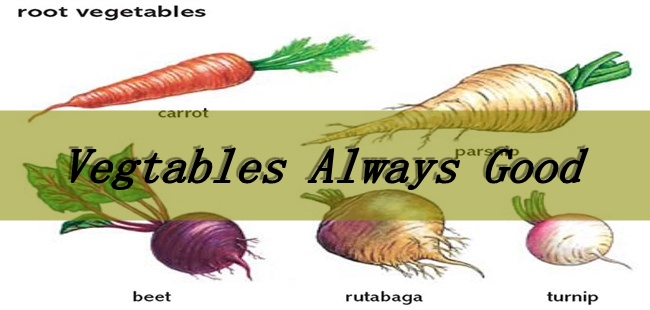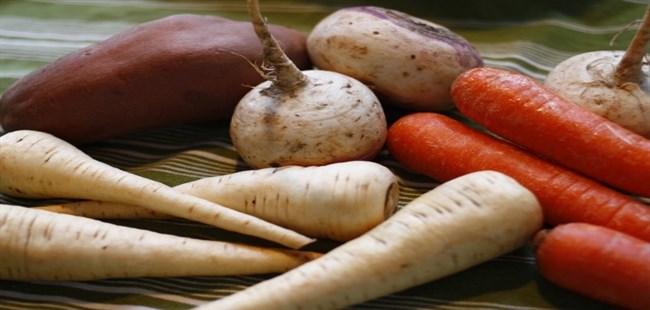Root vegetables
This category includes root vegetables such as carrots and turnips, as well as foods that are really tubers, the swollen roots of plants such as potatoes or yams.
Root vegetables are good sources of vitamins and fiber, especially if the skins are not removed before cooking.
Adding Interest
Keeping the tops Trim all but X in (2 cm) of the leafy tops from baby carrots and turnips, then cook and serve whole.
Making Carrot Flowers
Run a canelle knife or a fork crosswise down the length of a peeled carrot to make grooves. Then slice the carrot crosswise, producing flower shapes.
Preparing Roots
• Beets: Leave the roots and tops of whole beets untrimmed before boiling them, to prevent juices and color from leaking out.
• Potatoes: To make crisp fries, rinse sliced potatoes in cold water to remove excess starch. Dry them thoroughly on paper towels before frying.
• Jerusalem artichokes: To avoid annoying peeling, boil Jerusalem artichokes whole in their skins. The skins will rub off easily after cooking,
• Young vegetables: Peel young root vegetables thinly or scrub them, because the peel is high in fiber and the flesh just under it is high in nutrients.
A Good Idea
For really crisp, golden roast potatoes, make “hasselbacks”. Peel the potatoes then cut thin slices downward, not quite all the way through. Brush with oil, sprinkle with salt and bake in a hot oven for 30-40 minutes until crisp and well browned.
Salad Vegetables
Most salads need little preparation apart from the careful cleaning and trimming of all the ingredients to ensure that as many nutrients as possible are retained. To prevent loss of crispness, flavor, and vitamins, avoid preparing salad vegetables too far in advance.
Preparing Leaves & Tearing Lettuce Leaves
• Always tear lettuce leaves, rather than cutting them with a knife, to make bite-sized pieces.
• Removing the core: To take out the tough core from an iceberg lettuce, bang the lettuce firmly — core downward — on a countertop. Turn it over, and you should be able to twist and remove the core easily.
• Drying the leaves: If you do not have a salad spinner, dry washed leaves by rolling them loosely in a clean dish towel. Hold both ends firmly, and shake the towel gently.
• Refreshing lettuce: To revive a limp head of lettuce, trim the stem and dip it into iced water for a few minutes.
Stringing Celery
To remove the tough strings quickly from the outer sticks of celery, separate all the celery ribs, and lightly stroke a swivel-bladed vegetable peeler down the length of each one.
Preparing Cucumber
Use a melon bailer to scoop out the seeds from a cucumber before dicing or slicing. Cut the cucumber in half lengthwise, and scrape the melon bailer down the middle to remove the seeds.
Fruit Vegetables
These include sun-ripened vegetables such as eggplants, sweet peppers, tomatoes, and avocados. With their bright colors and fresh, rich flavors, fruit vegetables play an important role in ensuring that our everyday diet is not only varied, but also appetizing and nutritious.
Cutting Eggplants: Scoring Cut a diamond pattern in the flesh of eggplant halves before grilling or baking, to ensure even cooking throughout.
Removing Bitter Juices
To reduce the bitterness of eggplant, lay slices in a colander, and sprinkle with salt. Drain for 30 minutes, rinse, and dry. This also reduces oil absorption.
Peeling
Blanching To peel tomatoes, place them in a pan of boiling water. Remove after one minute and place in cold water. The skins will peel off easily.
Grilling Peppers
To skin whole peppers, place on foil, and grill until the skins blacken, turning often. Wrap the foil over so that steam will loosen the skins, then remove them.
Time Saving Tip
Peeling a ripe avocado: Instead of trying to peel a ripe avocado with a knife, cut the avocado in half, and scoop out the flesh from each half ill one piece using a large metal spoon. Keep the spoon close to the peel.
Other Vegetables
All kinds of vegetables, from all over the world, can be found in supermarkets today. Many do not fit into traditional categories, and some are, strictly speaking, not vegetables at all. Mushrooms are edible fungi, but they can be prepared in ways similar to many vegetables.
Cleaning and Trimming
• Corn on the cob: Use a clean nylon hairbrush to remove the silk threads from corncobs without damaging the kernels.
• When trimming the stalks from okra, ensure that you do not pierce the central parts and so release’ the sticky juices from the insides.
• Chilies: If you need to reduce the strength of chilies for a milder flavor, scrape out the seeds and membranes inside. Wash your hands well or wear rubber gloves while preparing chilies, since they can irritate eyes or skin.
• Zucchinis: If you are grating zucchini for a salad, stir-fry, or stuffing, leave the stem on to give you a grip as you work.
Pureeng Squash
Removing fibers: To make a really smooth purée of cooked squash, whip with an electric mixer. The blades will pick up any fibrous strings during the process so that you can remove them easily.
Mushrooms
Cultivated mushrooms should not be peeled or washed since this reduces their flavor and vitamin content.
• Cleaning: Wipe mushrooms gently with damp paper towels to remove din.
• Keeping color: To ensure that cultivated mushrooms stay white during cooking, sprinkle with lemon juice.
• Retaining vitamins: When marinating raw mushrooms, cover tightly with plastic- wrap to prevent contact with the air and loss of vitamins.
• Refreshing: To plump up dried mushrooms before use, immerse in boiling water for one minute. Dry before use.






